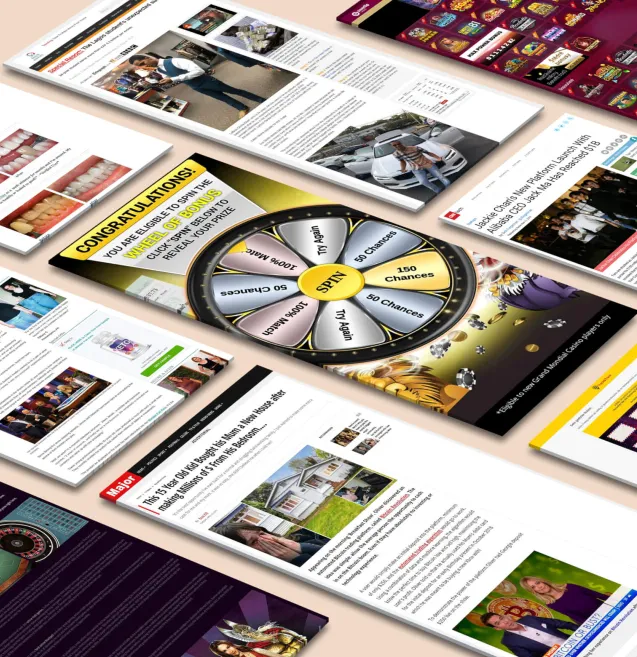
Наши инструменты отслеживают миллионы нативных объявлений из более чем 60 стран и у тысяч издателей.
НачатьGenerative AI is changing the way marketers create content, gain insights, and find solutions. It uses complex algorithms to analyze large amounts of data and generate outputs that mimic human thinking. This technology is a game-changer for marketers who want to automate and personalize their strategies on a larger scale than ever before.
With the rise of native advertising—ads that blend in with the platform's content—traditional disruptive advertising methods are being rejected by consumers. Marketers now need ads that feel natural, relevant, and valuable to their audience.
This is where generative AI comes in. It has the power to automate the creation of personalized native ad copy on a large scale, customizing messages for different audience segments or even individual users. By using micro-segmentation and adaptive content that responds to user interactions in real-time, marketers can deliver highly relevant marketing experiences across various channels without compromising quality for quantity.
In this article, we will explore how generative AI is personalizing native ad copy at scale. We will discuss the capabilities of this technology, its practical applications, implementation strategies, real-world success stories, and the future of AI-driven advertising personalization.
Generative AI in marketing uses advanced machine learning models trained on large datasets to create original content that resembles human creativity. These systems examine patterns, language structures, and visual elements from the data they were trained on, and then generate new outputs that are high-quality and relevant without needing a human to directly intervene for each piece.
The technology is built on two main principles: extensive data analysis and human-like reasoning abilities. AI models look at customer behavior data, engagement metrics, demographic information, and past campaign performance to understand what appeals to specific audiences. This analytical basis allows the systems to make smart choices about tone, messaging, and creative direction—similar to the strategic thinking a human marketer would use.
AI content generation for marketing covers a wide range of formats:
The advantages of automated content creation through generative AI are transforming marketing operations:
Native advertising blends seamlessly into the platform where it appears, matching the form and function of surrounding content. Unlike traditional display ads that interrupt user experience with obvious promotional messages, native ads feel organic—they look like editorial content, social media posts, or recommended articles. This subtlety makes them less intrusive and more engaging for audiences.
The integration of generative AI in this field is transforming how brands create these seamless experiences. For instance, AI native ad copywriting analyzes platform-specific formatting requirements, audience preferences, and content consumption patterns to generate copy that mirrors the editorial voice of each placement. You get ad copy that reads like a natural extension of the content your audience already trusts, maintaining brand aesthetics while adapting to different contexts.
The automation happens through sophisticated algorithms that understand context, tone, and messaging hierarchy. Generative AI pulls from your brand guidelines, product information, and performance data to craft personalized native ads that resonate with specific audience segments. The system can produce hundreds of variations—each tailored to different demographics, interests, or behavioral patterns—in the time it would take a human copywriter to draft a handful.
Real-world applications include generating sponsored content headlines for news sites, creating in-feed social media ads that match platform-specific styles, and producing recommendation widget copy that aligns with publisher content. E-commerce brands use AI to generate product-focused native ads that adapt messaging based on user browsing history and purchase intent signals.
Micro-segmentation transforms how you approach personalized native ads by dividing your audience into highly specific groups based on granular behavioral, demographic, and psychographic data. Unlike traditional segmentation that might categorize users into broad buckets, micro-segmentation creates hundreds or even thousands of distinct audience clusters—each with unique preferences, pain points, and purchasing behaviors.
Generative AI makes this level of precision actionable. You can now target a 35-year-old urban professional who shops for sustainable fashion on mobile devices during evening hours with completely different ad copy than a 42-year-old suburban parent browsing eco-friendly products on desktop during lunch breaks. The AI analyzes real-time data signals—click patterns, browsing history, engagement metrics—to generate adaptive content that evolves based on each user's journey.
This is how generative AI is personalizing native ad copy at scale: the technology creates multiple variations simultaneously, testing and refining messages as users interact with them. When someone clicks on a headline about "sustainable materials," the AI adjusts subsequent messaging to emphasize environmental benefits. If another user engages with pricing information, the content shifts to highlight value propositions.
The advantage of scalable ad personalization with AI lies in maintaining relevance across thousands of micro-segments without exponentially increasing your workload. You're delivering individualized experiences that feel crafted for each person, building stronger connections while your AI handles the complexity behind the scenes.
Automation in advertising transforms how marketing teams approach content creation. Generative AI eliminates the manual labor involved in writing hundreds of product descriptions or crafting multiple ad copy variations. You can now generate compelling native ad content in seconds rather than hours, allowing your team to produce volume without sacrificing quality.
The creative production process accelerates dramatically when you leverage AI for rapid content variation testing. You can create dozens of headline options, body copy alternatives, and call-to-action phrases simultaneously. This capability means you test more creative concepts in a single day than traditional methods allow in weeks. Your campaigns benefit from data-backed insights about which messaging resonates most effectively with specific audience segments.
Scalable ad personalization becomes economically viable through AI-driven automation. The technology handles the heavy lifting of content generation while your marketing team redirects energy toward strategic initiatives:
Generative AI in advertising delivers cost-effectiveness by reducing the need for large content creation teams. You maintain creative output at scale while controlling operational expenses. Your human resources focus on tasks requiring emotional intelligence, strategic thinking, and creative innovation—areas where human expertise remains irreplaceable.
Generative AI transforms raw customer data into actionable intelligence that drives campaign performance. You can train these models on extensive datasets—including purchase history, browsing behavior, demographic information, and engagement patterns—to create highly customized outputs that resonate with specific audience segments. The more proprietary data you feed into your AI systems, the more refined and brand-specific your native ad copy becomes.
Data-driven decision-making shifts from guesswork to precision when AI analyzes customer sentiment across multiple touchpoints. These systems process social media comments, product reviews, support tickets, and engagement metrics to understand how audiences perceive your brand and messaging. You'll see patterns emerge that human analysts might miss, revealing which emotional triggers, pain points, and value propositions generate the strongest responses.
Predictive analytics in advertising campaigns takes optimization to another level by anticipating consumer behavior before it happens. Your AI models identify trends in historical data to forecast which audience segments will respond to specific messaging, what time of day generates peak engagement, and which creative elements drive conversions. This foresight allows you to adjust campaigns proactively rather than reactively.
The continuous feedback loop between campaign performance and AI refinement means your native ads improve with every impression. You're not running static campaigns—you're deploying intelligent systems that learn, adapt, and optimize messaging strategies in real-time based on actual customer interactions.
Data quality challenges stand as the foundation of successful generative AI implementation. You need clean, comprehensive, and accurate datasets to train your AI models effectively. Incomplete or biased data produces flawed outputs that can damage your brand reputation and waste advertising spend. When your training data contains errors or inconsistencies, your generative AI will replicate and amplify these problems across thousands of ad variations.
Privacy concerns in AI marketing demand your immediate attention as regulations like GDPR and CCPA reshape how you collect and use customer information. You must establish transparent data collection practices and obtain proper consent before feeding customer data into your generative models. The tension between personalization and privacy creates a delicate balance—you want to deliver relevant ads without crossing ethical boundaries or violating consumer trust.
How Generative AI is Personalizing Native Ad Copy at Scale requires careful governance frameworks. You need to implement:
The technical complexity of integrating generative AI with existing marketing infrastructure presents another hurdle. You'll face compatibility issues, require specialized expertise, and need significant computational resources to run these models effectively at scale.
JPMorgan Chase deployed an AI-powered copywriting tool that analyzed years of historical ad performance data to generate personalized native ads examples across digital channels. The bank reported a 450% increase in click-through rates compared to human-written ads, with the AI system creating hundreds of variations tailored to different customer segments based on financial behaviors and demographics.
Stitch Fix, the online styling service, uses generative AI to create personalized product descriptions and native ad copy at scale for millions of clothing items. Their AI analyzes customer style preferences, body measurements, and past purchases to generate unique ad messaging for each user. This approach contributed to a 25% improvement in conversion rates and significantly reduced content creation time from weeks to hours.
Nutella leveraged generative AI to create seven million unique jar designs and corresponding native ad campaigns across social media platforms. Each design was personalized based on regional preferences and cultural nuances, resulting in over 3 million jars sold within the first month of the campaign launch.
Sephora's AI-powered chatbot serves as a prime example of generative AIs use cases advertising, engaging customers through personalized product recommendations and creating custom native ad experiences based on real-time conversations. The chatbot handles over 5 million conversations monthly, delivering personalized beauty advice while generating native ad copy that reflects individual customer needs and preferences.
The future of generative AI's advertising landscape promises capabilities that will fundamentally reshape how you approach native ad campaigns. Emerging technologies are pushing boundaries beyond simple text generation into sophisticated multi-modal content creation that seamlessly blends copy, visuals, and interactive elements.
Evolving native technology will enable you to achieve unprecedented levels of personalization. We're moving toward AI systems that understand context across entire customer journeys, not just individual touchpoints. You'll see generative models that create cohesive narratives spanning email, social media, display ads, and in-app experiences—all while maintaining your brand voice and adapting to real-time behavioral signals.
The integration of advanced sentiment analysis and emotional intelligence will allow your AI-powered native ads to respond to subtle consumer mood shifts. You'll be able to deploy campaigns that adjust tone, messaging, and creative elements based on current events, trending topics, or individual user states.
How Generative AI is Personalizing Native Ad Copy at Scale will expand to include predictive content generation—where AI anticipates consumer needs before they're explicitly expressed. Your role as a marketer will shift from content creator to strategic orchestrator, focusing on setting parameters, defining brand guardrails, and interpreting AI-generated insights to inform broader business decisions.
The technology will democratize sophisticated advertising capabilities, allowing smaller brands to compete with enterprise-level personalization strategies.
Получайте лучшие конверсионные лендинги каждую неделю на свою почту.
Коротко
Priya Kapoor
7 миннояб. 14, 2025
Инструкция
Нативная реклама изменила облик цифрового маркетинга, плавно вписывая рекламный контент в органичный пользовательский опыт. В отличие от традиционных баннеров, которые прерывают ваш серфинг, нативные объявления естественным образом интегрируются в поток контента платформы, благодаря чему они кажутся скорее ценной информацией, чем рекламой.
Elena Morales
7 миннояб. 8, 2025
Коротко
Смена креативов в нативной рекламе — это регулярное обновление и изменение визуальных элементов, сообщений и форматов вашей рекламы, чтобы поддерживать интерес аудитории. Это как обновить внешний вид ваших кампаний до того, как ваша аудитория полностью потеряет к ним интерес. Вот в чем суть: когда вы многократно показываете одну и ту же рекламу одним и тем же людям, они перестают обращать на нее внимание. В результате ваши показатели переходов падают, расходы растут, а эффективность кампании снижается. Это явление — усталость от рекламы в нативной рекламе — незаметно разрушает иначе успешные кампании.
Dan Smith
7 миннояб. 2, 2025




